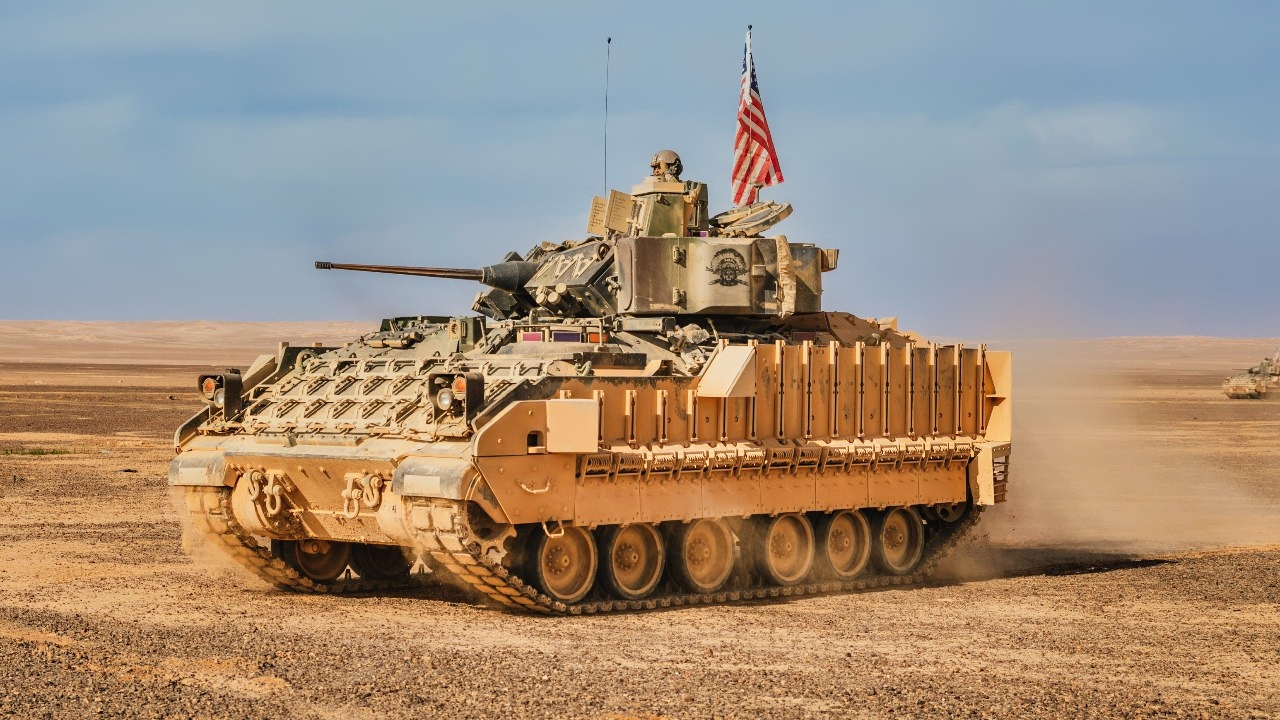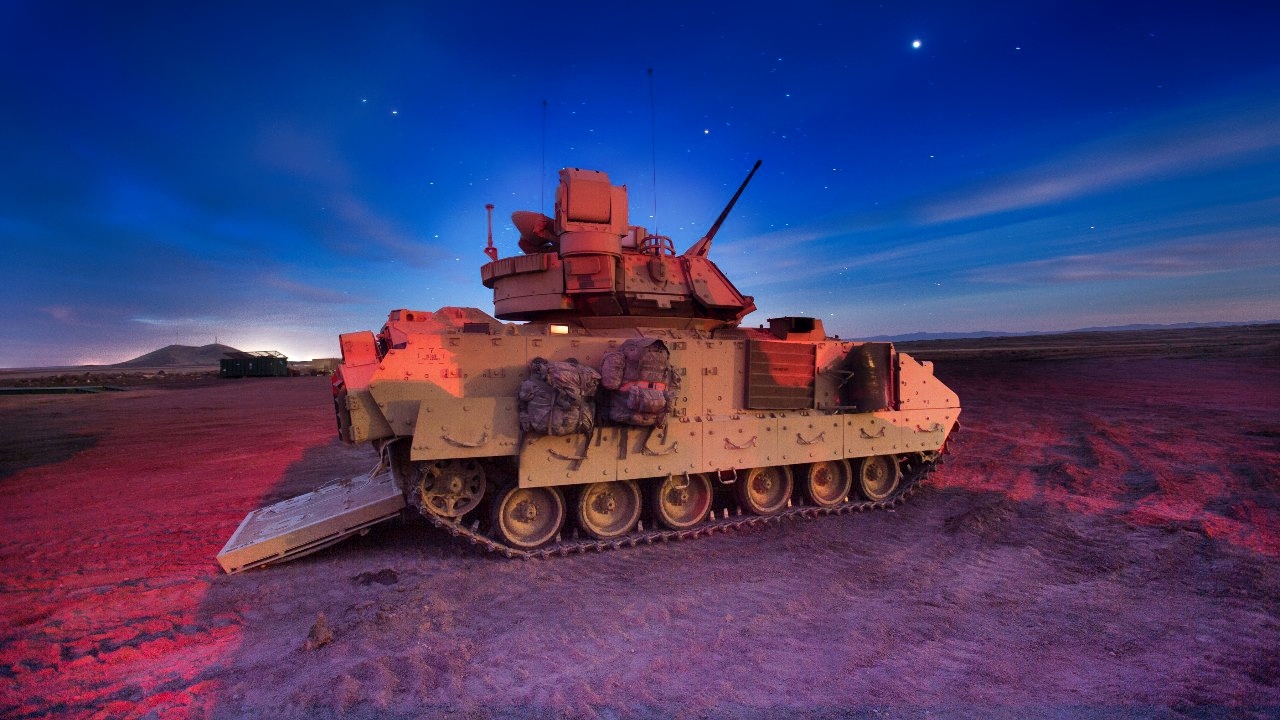Key Points and Summary – The Army’s Bradley Fighting Vehicle is living a paradox: it has never been more lethal or more constrained.
-Years of add-on armor, APS, and Iraq-era survivability kits have pushed the platform to its size, weight, and power limits, even as the A4 and emerging A5 variants add new engines, computing, 3rd-gen FLIR, APS, and potential laser and counter-drone weapons.

Aerial drone image of Bradley Fighting Vehicle crews from the 1st Armor Brigade Combat Team, 3rd Infantry Division, conducting Table XII gunnery at Fort Stewart, Ga. December 7, 2016.

Troopers with 3rd Armored Brigade Combat Team, 1st Cavalry Division firing the 25mm canon on a Bradley fighting vehicle in order to zero the vehicles weapons systems at a range in Poland. Ranges such as these familiarize troopers with the vehicles systems in order to ensure combat readiness.
-These upgrades “buy back” mobility and create digital backbone for EW, AI-enabled sensing, and SHORAD-style missions—but only up to a point.
-The Bradley A5 is a bridge, not a destination, underscoring why the Army needs a clean-sheet XM30 for the next fight.
The U.S. Army’s Bradley Has Hit Its Limit – Enter the XM30
There is a paradoxical quality to the Army’s continued Bradley upgrades, as both massive improvements and limitations drive the need for the XM30.
Essentially, a legacy platform such as the Bradley can only be upgraded to a certain extent before “size, weight, and power” constraints limit upgrade possibilities.
Future combat vehicles, for example, will need new levels of onboard electrical power, electronic weapons (EW), and space for soldiers and ammunition.
The Bradley has been upgraded so many times over the years that it has essentially “maxed out” and reached its limit.
“Maxed Out” Bradley
Some survivability enhancements needed to counter threats in Iraq wound up maxing the Bradley’s weight and on-power capacity.
For instance, Army developers explain that equipping the Bradley with new suspension, reactive armor tiles, and APS can increase the vehicle’s weight by up to 3,000 pounds.
However, this does not mean that the most cutting-edge Bradley variants are not extremely useful and impactful.
In recent years, the Army purchased 473 of the most modern Bradley M2A4 and M7A4 vehicles, platforms with new computing, weapons sights, digital processors, and long-range sensors.
Army weapons developers have publicly stated that the newest Bradley A4s include upgrades to the engine and transmission, modifications to the cooling system, electrical system upgrades, and the introduction of vehicle diagnostics.
The upgrades, as explained by Army weapons developers, “bought back” some of the lost mobility and added the technical infrastructure sufficient to accommodate new weapons and sensors, as well as emerging electronics and communications systems.
Bradley A5
Building upon this progress, the Army has also been progressing quickly in recent years on the Bradley A5, likely armed with lasers, counter-drone missiles, active protection systems, vastly improved targeting sights, and increased onboard power to accommodate next-generation weapons and technologies.
Designed to be lighter, more mobile, and much better protected, emerging Bradley A5 lethality upgrades are part of a plan to build on improvements from the A4.
More onboard power can bring the technical means to support significantly advanced electronics, command and control systems, computing power, sensors, networks, and even electronic warfare technologies.
US Army weapons developers have explained the upgrades in terms of A3 and A4, focusing on the Bradley from the turret ring down, while the A5 effort is modernizing Bradley systems from the turret up more heavily.

U.S. Army Soldiers assigned to 2nd Squadron, 278th Armored Cavalry Regiment, Task Force Reaper, conduct movement procedures with M2 Bradley Fighting Vehicles during the Jade Cobra VI exercise in the U.S. Central Command’s area of responsibility, Feb. 19, 2025. Jade Cobra VI strengthens military-to-military partnerships, increases readiness, and facilitates security cooperation between the United States and Jordan. (U.S. Army photo by Staff Sgt. Hector Tinoco)
This includes weapons sights, guns, optics, next-generation signals intelligence, and even early iterations of artificial intelligence and increased computer automation.
The improved weapons sights on the Bradley A5 include 3rd-Generation Forward Looking Infrared Sensors and Commanders’ and Gunners’ sights.
The A5 is also being built with added armor protection and ammunition storage, as well as a technology referred to as “spot trackers.”
Also, while Army Bradley developers have not specifically said they planned to arm Bradleys with laser weapons, such innovation is well within the realm of the possible. Active Protection Systems also figure prominently in this equation, as they can leverage advanced computing and fire control to detect, track, and intercept incoming anti-armor weapons and RPGs.
Bradley Fires Lasers
APS systems, targeting sights, and lasers can also be integrated with Short Range Air Defense possibilities.
SHORAD, as it’s called, is an air defense program that equips Stryker vehicles with HELLFIRE and Stinger missiles, enabling them to track and destroy enemy drones, helicopters, and low-flying fixed-wing platforms.
The emergence of these weapons for the Bradley and the fast-changing threat calculus is also, quite naturally, impacting what Army developers call CONOPS, or Concepts of Operations.
Longer range sensors and weaponry, of course, can translate into a more dispersed combat area – thus underscoring the importance of command and control systems and weapons with sufficient reach to outrange attacking forces.

Engineers with the 116th Brigade Engineer Battalion conduct M2A3 Bradley fighting vehicle gunnery qualification on March 27, 2018, Orchard Combat Training Center, south of Boise, Idaho. Combat engineers with the 116th BEB trained through gunnery table XII, evaluating their ability to execute collective platoon-level tasks in a tactical live-fire environment; including integrating dismounted soldiers with their assigned BFV. (U.S. Army National Guard photo by 1LT Robert Barney)
The idea of increasing Bradley’s lethality is not only about directly destroying enemy targets but also about laying down suppressive fire to enable forces to maneuver in combat.
About the Author: Kris Osborn
Kris Osborn is the President of Warrior Maven – Center for Military Modernization. Osborn previously served at the Pentagon as a highly qualified expert in the Office of the Assistant Secretary of the Army—Acquisition, Logistics & Technology. Osborn has also worked as an anchor and on-air military specialist at national TV networks. He has appeared as a guest military expert on Fox News, MSNBC, The Military Channel, and The History Channel. He also has a Masters Degree in Comparative Literature from Columbia University.
More Military
Montana-Class vs. Yamato-Class: It Would Have Been the Ultimate Battleship Battle
The Littoral Combat Ship Might Be the Navy’s Biggest Mistake Ever










